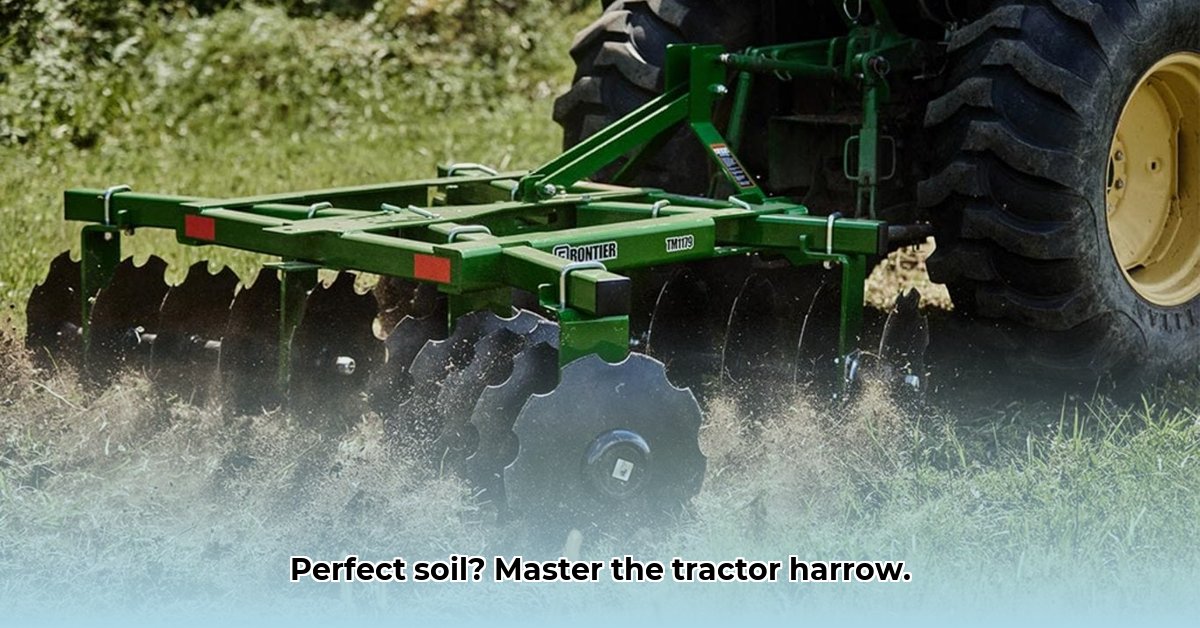
Understanding Tractor Harrows: More Than Just a Fancy Name
Tractor harrows are implements pulled behind a tractor to level, smooth, and break up soil clumps. They transform rough, freshly plowed fields into perfectly prepped seedbeds, crucial for successful planting. Various types cater to different soil conditions and farming needs. Choosing the right harrow is key to maximizing its effectiveness. For more information on tractor implements, see this helpful guide: Tractor Seeding Guide.
Different Harrows for Different Needs: Finding Your Perfect Match
Several types of tractor harrows exist, each with its strengths and weaknesses. The right choice depends on soil type, desired outcome, and farming practices.
Disk Harrows: These use rotating disks to cut and pulverize soil, ideal for heavy clay soils or fields with abundant plant residue. They excel at breaking up stubborn clods, but their high fuel consumption and potential for soil structure damage if overused must be considered.
Spring-Tooth Harrows: These feature spring-loaded tines that aggressively till the soil, effectively controlling weeds and improving aeration for healthy root growth. While excellent for lighter, loamier soils and weed control, they're less effective than disk harrows at creating fine soil.
Smoothing Harrows: These provide the final touch, creating a perfectly smooth, even surface for planting. They don't break up large clods, but ensure optimal seed-to-soil contact.
Mastering Tractor Harrows: A Step-by-Step Guide
Effective harrow usage is key to successful soil preparation. Here's a step-by-step guide:
Pre-Flight Check: Inspect the harrow for bent, broken, or missing parts before operation. Replace damaged components to ensure safety and optimal performance.
Depth and Angle Adjustment: Adjust the harrow's depth and angle according to soil conditions. Heavier soils may require shallower passes, while lighter soils can tolerate deeper ones. Experimentation is key.
Speed Control: Maintain a moderate speed. Excessive speed reduces tilling effectiveness, while overly slow speeds waste time and fuel. Find the optimal balance through experience.
Overlapping Passes: Slightly overlap each pass to ensure even soil preparation, preventing missed areas and stripes.
Post-Harrow Inspection: After completion, inspect the field. Additional passes may be needed in specific areas to achieve uniform soil preparation.
Keeping Your Harrow Happy: Maintenance Tips
Regular maintenance is critical for extending the life and maximizing the performance of your tractor harrow.
Lubrication: Regularly lubricate moving parts to prevent rust and wear, crucial for spring-tooth harrows.
Wear and Tear Inspection: Regularly check for wear and tear and replace damaged components promptly.
Proper Storage: Store the harrow in a dry area to prevent rust and cover it if not stored indoors.
The Big Picture: Why Bother with Tractor Harrows?
Tractor harrows offer significant benefits:
Improved Soil Aeration: Enhanced aeration promotes better root growth and healthier plants, leading to increased yields.
Effective Weed Control: Breaking up soil and burying weed seeds reduces weed growth, keeping crops healthy.
Optimal Seed-to-Soil Contact: Smooth seedbeds ensure better seed-to-soil contact, improving germination and yields.
Considering the Downsides: A Balanced Perspective
While beneficial, tractor harrows have potential drawbacks:
Soil Erosion Risk: Over-tilling can damage soil structure, increasing erosion susceptibility. Careful usage and avoiding excessive passes are crucial.
Fuel Consumption: Fuel consumption, especially with heavier harrows, can be significant. Minimizing passes helps conserve fuel.
Potential Environmental Impacts: Some research suggests excessive tillage can negatively affect soil health and microbial life. Consider no-till or reduced-till options.
By understanding the different harrow types, their proper usage, and maintenance requirements, farmers can harness their full potential for optimal soil preparation and bountiful harvests.